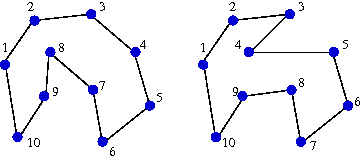CS 5114 Homework 5 (Spring 2008)
Assigned on Wednesday, March 27, 2008. Hardcopy due at the
beginning of class Wednesday, April 2,
2008.
Describe your algorithms as clearly as possible. The style used
in the book is fine, as long as your description is not ambiguous.
Do not make any assumptions not stated in the problem. If you do
make any assumptions, state them clearly, and explain why the
assumption does not decrease the generality of your solution. If you
use any new words or phrases, define them, especially if we have not
used these words/phrases in class. Do not describe your
algorithms only for a specific example you may have worked out. You
must also provide a clear proof that your solution is correct (or a
counter-example, where applicable). Describe an analysis of your
algorithm and state its running time.
- (40 points) The Headstrong Headless Horseman
Problem (not to be confused with Ichabod
Crane's problem with the Headless Horseman) is the following:
The Horseman has to find his head, which he has hidden at one of
n places in a forest. However, the Horseman has forgotten
where he hid his head. He decides to search for it by travelling
to each hiding place. Since the Horseman is familiar with
Cartesian geometry, he knows the x- and
y-coordinates of each possible hiding place. Being
headstrong, the Horseman wants to
- start at the leftmost hiding place,
- return to this hiding place at the end of his search,
- visit each other hiding place exactly once, and
- start riding from left to right till he reaches the
rightmost point and then ride from right to left till he reaches
the leftmost point.
Thus, his journey can be divided into two parts: in the
first part, the x-coordinates of the places he visits
keep increasing and in the second part the x-coordinates
of the places keep decreasing. Note that the y-coordinate
of a place he visits may be larger or smaller than the
y-coordinate of the place he visits next.
Assume that no two hiding places have the same x- or
y-coordinates and that the horseman rides in a straight
line from one place to the next.
The figure below shows two journeys,
with the numbers indicating the order in which the horseman visits
the hiding places. The tour on the left is legal. The tour on the
right is not legal because the third point has an
x-coordinate larger than that of the fourth point.

You have recently moved to the
forest. The Horseman asks you for help. Devise an algorithm that will
compute a journey of shortest length that satisfies the Horseman's
constraints (otherwise, you will lose your head).
- (30 points) Solve exercise 6 in Chapter 7 (pages 416-417) of
your textbook.
- (30 points) A flow network has m edges. Show that
there exists a sequence of at most m augmenting paths
that yield the maximum flow. In other words, if you prove this
statement, you would have shown that if the augmenting paths were
chosen correctly (by magic), the Ford-Fulkerson algorithm will
terminate in at most m iterations. Note that this
question is not algorithmic: you do not have to demonstrate an
algorithm to compute these augmenting paths.
